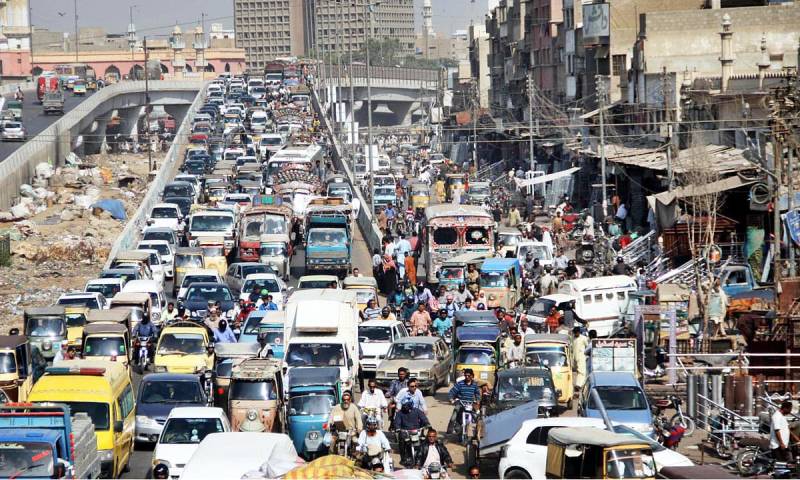
There are two classes in the world, and by reduction in Karachi, the leisure class and all others. I am not a communist, so I shall not construct a case against the rich of the city, but one could be made if I were to argue that the rich have a greater social duty and “the leisure class” exists perhaps in greater and more voluptuous significance on that tier of the hierarchy.
I took a train to Karachi. Before I reached the Cantt junction, another train, the Awami Express, bound for Lahore, had faced three tragic deaths on the tracks around Sialkot - two brothers and a friend, all below the age of eighteen. Sultan, the oldest of the group, fifteen years of age, died first. They jumped out after the ticket collector told them that they would be thrown in jail when the train reaches the next stop. This is not an article about Sultan, this story was mentioned to show my relief as I got out of the business section.
I was supposed to be at a national debating tournament to be held at an elite school of the city, Karachi Grammar School. We were a pack of government college gentlemen often referred to as “wandaas” by our more localized friends in the circuit. We happened to stay at the Karachi University’s old guest house because our advisor had arranged so. The rickshaw driver there explained that we should avoid the North side of the city, specifically North Nazimabad, for it was riddled with phone snatchers and petty criminals. On my asking, we were told that the location we were driving towards was perhaps not the safest. Asghar, the driver, told us that the situation in the North, as well as in the peripheries, had rather improved with the deportation of Afghans - the undocumented minority being forced out the country.
I was interested in seeing the area where children once played with corpses - Lyari. Asghar told me that Lyari was safer after the Rangers conducted an operation in 2016 and later helped built the neighborhood. In 2016, Ozair Baloch was captured by the Rangers after a volatile search operation that was spurred by more than a thousand deaths every calendar year for more than half a decade.
There was a time in this city when a target killer was cheaper than a pack of imported cigarettes. We visited the old Bans Road on a local bus. The recommendation was given by Saleem, an NED university graduate, with whom we became acquainted on the bus bound for Kemari. Saleem told us that just a few days ago, two police officers jumped on an Afghani man, who was in his late 50s, to take him to the deportation facility, lest he pays them ten thousand rupees. The Afghani man bargained a deal for seven thousand and was let go. He might never get his CNIC and will most definitely be deported back to the Taliban controlled country.
A significant population of Afghans are facing a mass exodus, around 1.7 million, because of a deadline given by PM Kakar. It is crucial to note that the total population of Afghanis in Pakistan crosses 4 million and most of them make a decent contribution to the economy and own established shops in markets throughout the country, but their presence is particularly felt in the markets of Karachi.
In 1979, the people migrating to the country were not only broken families, but also active combatants of splinter terrorist groups, bringing with them ammunition and heavy artillery from across the border. Karachi then was not only divided into two, the poor and the rich, but also had multiple neighborhoods engaged in internal warfare, the blood of which bled in the most preserved streets of the metropolitan. Weapons found their way from Dara to Mardan, to Nawa-e-Qilla, Talagang, Ghotki, Nawabshah, Hyderabad and finally to the “Kachi Abadi” of Karachi. From here, they were used by the gangsters, terrorists, parties and petty criminals; all the same. These groups turned “Kati Pahari” from a beautiful communed housing space made by the Saudis in 1960’s to a graveyard.
From ANP to PPP and MQM, all had established muscle. Uzair Baloch himself was a politician before he became a gang member with ties to the PPP. All of this unfolded after the murder of his father by the hands of Arshad Pappu in 2003. Arshad was an MQM pawn being played to take over the world of crime, along with the seats in the provincial assembly. The resulting gang war took an ethnic turn with Muhajirs and Pashtuns playing a politically motivated game of Russian roulette. The healing began after the joint operations of the military, which involved intelligence operations, Rangers and some segments of the CTD of police.
Karachi is calmer today. Much to the great dismay of many civilians in the government’s employ, the Rangers still enjoy almost double pay in the city compared to employees in other governmental institutions. The Parsi colony is still gated and guarded - to protect the fading remnants of Zoroastrians who helped the city through their inextricable trinity of culture, wealth and social connections.
The tournament in which we were meant to compete was coming to an undesirable, but heavily predictable end. I was deliberating whether to call my employer for an early loan and take the plane home as I took a puff from a friend’s cigarette. The last question of significance for me was whether the affluent class of this tumultuous city would turn out to be another batch of the leisure class. The answer I hope, is not silence.
The only canorous sound on our train ride back was of the children playing with broken sticks and mud on the railway tracks sequentially before every other station, all the way from the dessert of rural Sindh to the plains of Punjab.

